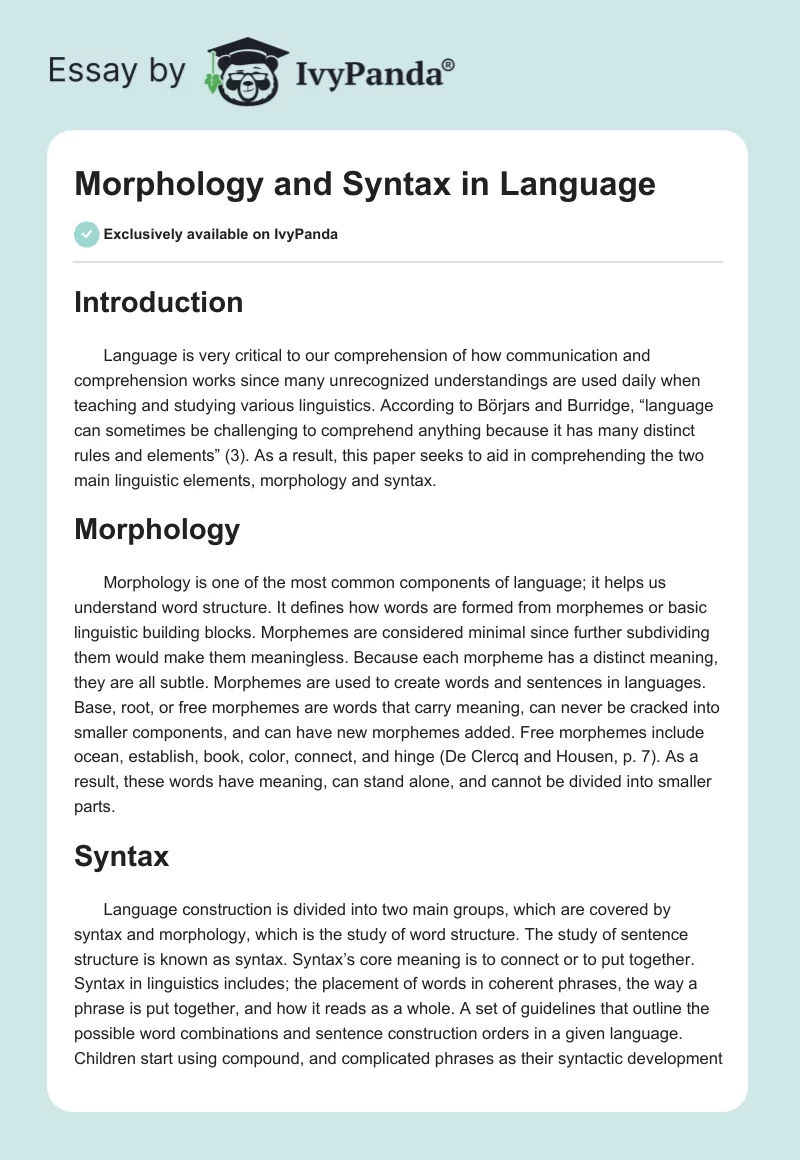Introduction
Language is very critical to our comprehension of how communication and comprehension works since many unrecognized understandings are used daily when teaching and studying various linguistics. According to Börjars and Burridge, “language can sometimes be challenging to comprehend anything because it has many distinct rules and elements” (3). As a result, this paper seeks to aid in comprehending the two main linguistic elements, morphology and syntax.
Morphology
Morphology is one of the most common components of language; it helps us understand word structure. It defines how words are formed from morphemes or basic linguistic building blocks. Morphemes are considered minimal since further subdividing them would make them meaningless. Because each morpheme has a distinct meaning, they are all subtle. Morphemes are used to create words and sentences in languages. Base, root, or free morphemes are words that carry meaning, can never be cracked into smaller components, and can have new morphemes added. Free morphemes include ocean, establish, book, color, connect, and hinge (De Clercq and Housen, p. 7). As a result, these words have meaning, can stand alone, and cannot be divided into smaller parts.
Syntax
Language construction is divided into two main groups, which are covered by syntax and morphology, which is the study of word structure. The study of sentence structure is known as syntax. Syntax’s core meaning is to connect or to put together. Syntax in linguistics includes; the placement of words in coherent phrases, the way a phrase is put together, and how it reads as a whole. A set of guidelines that outline the possible word combinations and sentence construction orders in a given language. Children start using compound, and complicated phrases as their syntactic development progress, which may be described as follows: Firstly, Compound clauses are made up of two or more separate clauses that are connected by a conjunction, a comma, or a semicolon (Börjars and Burridge, p. 25). One of the main characteristics of a compound sentence is that it lacks any subordinate clauses. Secondly, one independent clause and one or more dependent or subordinate clauses make up a complex sentence. Although it has a subject and predicate, a dependent or subordinate sentence cannot stand independently. Example: “If I have enough gas, I will drive to Reno. Therefore, languages have different syntax rules making syntax a critical component of language.
The Connection Between Language and Culture
Language and culture are intertwined; for instance, in many cultures, it is against the rules to use specific expressions with those older than you or who have a position of authority over you, your boss, for example. Different cultures frequently employ polite terminology that shows how well-integrated you are as a visitor to the culture and how intelligent or well-mannered you are as a native speaker. The language reflects the culture of the country or society. It is deeply ingrained in cultural thought, and frequently, a literal translation of the words and sentences might be inaccurate and improper from a cultural standpoint (De Clercq and Housen, p. 5). As a result, to communicate successfully in a language, it is crucial to invest the same time and energy into mastering the related culture.
Conclusion
Morphology and syntax play a significant role in language; morphology helps us to study the structure of different words, whereas syntax helps us study the structure of sentences. Also, language and culture depend entirely on each other; language is a powerful tool in shaping culture. The first thing the independent states did after the USSR collapsed was to bring back their languages to re-assert their independence. As a result, language and culture work hand in hand.
Works Cited
Börjars, Kersti, and Kate Burridge. “Introducing English Grammar.” 2019, Web.
De Clercq, Bastien, and Alex Housen. “The Development of Morphological Complexity: A Cross-Linguistic Study of L2 French and English.” Second Language Research, vol. 35, no. 1, 2016, pp. 71–97. Web.


